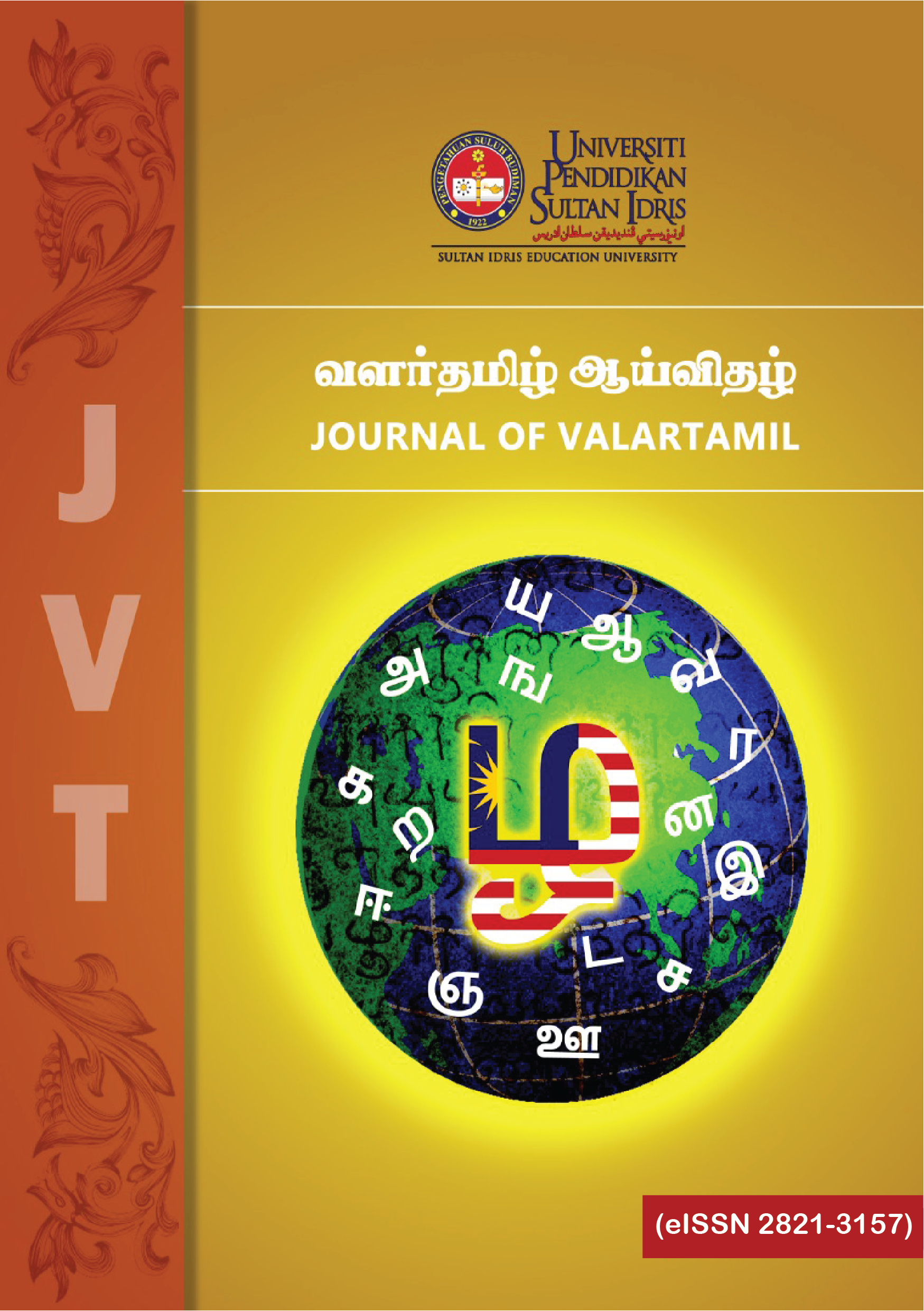மலேசிய இந்தியர்களிடையே குண்டர் கும்பல் சிக்கல்: எதிர்காலம் திரைப்படம் ஓர் ஆய்வு
Gangsterism among the Malaysian Indians: A study on Ethirkalam Movie
DOI:
https://doi.org/10.37134/jvt.vol1.2.7.2020Keywords:
மலேசியத் தமிழ்த்திரைப்படம், குண்டர் கும்பல், எதிர்காலம் திரைப்படம், சமூகவியல், குற்றவியல்Abstract
மலேசியத் தமிழ்த் திரைப்படத்துறையானது 1968-ஆம் ஆண்டு மு. பஹருதின் அவர்களால் தயாரிக்கப்பட்ட ரத்தப்பேய் எனும் திரைப்படத்தில் இருந்து தொடங்கியது. இது குறுகிய கால அளவைக் கொண்ட திரைப்படமே. அந்த வகையில் 1991-ஆம் ஆண்டு சுகன் பஞ்சாட்சரம் அவர்களால் தயாரிக்கப்பட்ட ‘நான் ஒரு மலேசியன்’ எனும் திரைப்படமே மலேசியாவின் முதல் முழுநீளத்திரைப்படமாக வரலாற்றில் இடம் பிடித்தது. வர்த்தக அடிப்படையில் இத்திரைப்படம் தோல்வியைத் தழுவியதால் அடுத்த 13 ஆண்டுகளில் எந்த மலேசியத் தமிழ்த்திரைப்படமும் தயாரிக்கப்படவில்லை. இதன் பின்னர் 2005-ஆம் ஆண்டு பென்சில் எனும் திரைப்படம் மலேசியத் தமிழ்த்திரைப்பட வரலாற்றினை மீண்டும் முன்னெடுத்துச் செல்லத்தொடங்கியது. சுபாஷ் அவர்களின் இயக்கத்தில் வெளிவந்த இத்திரைப்படம் மற்ற இளம் கலைஞர்களுக்கு இத்துறையில் ஈடுபட உத்தேகம் அளிக்கிறது. அதன் பின்னர் நீயா நானா, எதிர்காலம், ஆண்டாள், விக்ராந், மஞ்சரி என பல மலேசியத் தமிழ்த்திரைப்படங்கள் தயாரிக்கப்பட்டு வெற்றியும் கண்டன. ஒரு திரைப்படத்தின் வெற்றியானது அதன் கதைக்கருவில் அடங்கியுள்ளது. அக்கதைக்கருவானது ஒரு நாட்டில் வாழும் மக்களிடையே நிலவும் சமகாலச் சிக்கல்களைச் சார்ந்திருந்தால் மக்களிடத்தில் பெரிய வரவேற்பைப் பெறும். இவ்வாறு அமைவுரும் திரைப்படங்கள் சமகால வாழ்க்கையின் வரலாற்று ஆவணங்களாக அமைவதுடன் ஒரு சமூகத்தின் பண்பாட்டுப் பதிவாகவும் நிலைபெறும். அந்த வகையில் மலேசிய இந்தியர்களிடையே நிலவும் சமகாலச் சிக்கல்களுள் ஒன்றான குண்டர் கும்பல் சிக்கலை விளக்குவதுதான் எதிர்காலம் எனும் மலேசியத் தமிழ்த் திரைப்படம். இத்திரைக்கதையில் இச்சிக்கல் எவ்வாறு கையாளப்பட்டுள்ளது என்பதையும் அதன் உண்மை நிலை எவ்வாறு பொருந்தி இளையோர்களுக்குச் செய்தியைத் தருகிறது என்பதையும் ஆராய்வதே இக்கட்டுரையின் நோக்கமாகும். இந்த ஆய்வு, தரவுப்பகுப்பாய்வின் ஹெர்மனுதிக்குக் கோட்பாட்டை ஆய்வு நெறியாகப் கொண்டு மேற்கொள்ளப்பட்டுள்ளது.Abstract
The history of Malaysian Tamil movies began in 1968 with the short movie “Ratta Peei” by Mu. Bahruthin. Then, the first Malaysian full-length Tamil movie, “Naan Oru Malaysia” (I am a Malaysia) under the production and direction of Sugan Panjacharam, was released in 1991. Unfortunately, the film was unsuccessful, and its failure led to 13 years of drought in Malaysian Tamil movies. In the year 2005, the Malaysian Tamil film industry was revived again with the successful production of the movie “Pencil,” which inspired the local movie producers to produce a succession of local Tamil films like “Niiya Nana”, “Ethirkalam”, “Andal”, “Vikranth”, and “Manjari”, which were well-received by the local audience. The key to producing a successful film is to ensure that the film has a storyboard content reflecting society’s contemporary issues, which will make the film a historical and cultural asset of a society. “Ethirkalam” was one such movie that discusses the critical issue of gangsterism among Malaysian Indians. This article aims to discuss the portrayal of gangsterism in “Ethirkalam” and the message it wants to convey to the Malaysian youths. This is a qualitative research conducted based on hermeneutics approach.
Key words: Malaysian Tamil Movies, Gangsterism, Movie entitle Ethirkalam, Socialogy, and Criminal offence
Downloads
References
Guna, K., A. (2006). Kathal Manavaazkai, Kulanthai valarppu: sikkalum thiirvum. Chennai: Santha Publication.
Bordwell, David & Thompson, Kristin. (2008). Film Art. New York: MC Graw Hill.
Creswell W., John. (2003). Research Design Qualitative, Quantitative And Mixed Methods Approaches. (2nd Edition). London: Sage Publication, Inc.
Denzin K., Norman & Lincoln S., Yvonna,. (2003). Introduction: The Discipline and Practice of Qualitative Research. In K., Norman, Denzin and Yvonna, S., Lincoln (Eds.), Collecting And Interpreting Qualitative Materials. London: Sage Publication, Inc.
Goudlad, J., S., R. (1971). A Socialogy of Populoar Drama. London: Heinemann.
Hagedorn, John M., (2001). Gang. In World Book (Vol. 8, pp. 26). USA: World Book Inc.
Howell, Kerry E. (2013). An Introduction To The Philosophy Of Methodology. Singapore: Sage Publication, Inc.
Jesuthas. (2010). Cerpen-Cerpen Karya M.Shanmugasiva: Satu Kajian Tema Dan Struktur. (Disertasi Ijazah Sarjana yang tidak diterbitkan). Universiti Malaya.
Mccarthy, Thomas. (1978). The Critical Theory Of Jurgen Habermas. London: Hutchinson & Co, Ltd.
Melissa Freeman. (2008). Hermaneutics. In M., Given Lisa (Ed.), The Sage Encyclopedia of Qualitative Research Methods. (Vol. 1, pp. 385-388). London: Sage Publication, Inc.
Merrian, B., Sharan. (2009). Qualitative Research A Guide To Design And Implementation. San Francisco: A Wiley Imprint.
Michael Pyan & Melissa Lenas. (2012). An Introduction to Film Analysis. New York: Continuum.
Paul Madsen, Roy (1973). The Impact of Film, How Ideas Are Communicated Through Cinema And Television. New York: Macmillan Publishing Co. Inc.
Ragu Nelligan. (2002). Gengsterisme Di Kalangan Pelajar India Di Sekolah Menengah: Satu Kajian Kes di Petaling Jaya, Selangor. (Latihan Ilmiah yang tidak diterbitkan). Universiti Malaya.
Sabitha Marican. (2005). Kaedah Penyelidikan Sains Sosial. Petaling Jaya: Pearson Prentice Hall.
Stephenson, Ralph & Phelps, Guy. 1965. The Cinema As Art. London: Penguin Books.
Zygmunt Bauman. (1978). Hermeneutics and Social Science Approaches to Understanding. London: Hutchinson & Co, Ltd.





